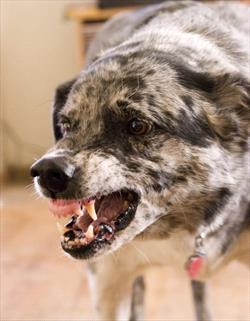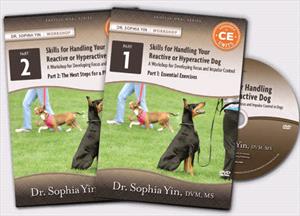Question:
I have a puppy who has had a lot of training and is almost perfect. The problem is, his tolerance for having his friends near his “stuff” is ZERO. Rosco is a very happy go lucky dog with his friends until someone gets near his treats or his toys…then this killer instinct in him comes out, its scary!
For instance, I accidentally left my treat bag on the hill at a park with a friend and her dog went to sniff it. Rosco attacked him and made him bleed! Yesterday I was playing fetch by the water and another dog came by to investigate the toy I was throwing and Rosco attacked him (They had been playing together so nicely until I made the mistake of getting his throw toy out of the car). I also think he would be possessive aggressive if I have a treat bag and another dog approaches. What should I do?
Signed
Puzzled in Pittsburg
Answer:
Possession aggression seems like such a puzzling problem; however, if you take a scientific approach then fixing the situation can be straightforward. It’s all about finding a way to help the dog feel like no one’s going to steal his stuff. So how do you do that? First figure out:
- What he’s afraid of having stolen and by whom (people or other dogs)
- Then think, how can I help him to feel good about these people and dogs approaching his stuff (Classical counterconditioning). How can I make him feel that their approach predicts a jackpot of prizes for him?
- How can I do this safely so no-one is at risk.
- How do I know when he’s learning what I hope he is?
- How many people (or dogs) and situations should I practice in before I can completely trust him?
In the next few blogs, I’ll provide a variety of examples. For a more thorough coverage of the use of science in your training and behavior modification programs, check out How to Behave So Your Dog Behaves.
Case 1: Food and Food Bowl Possession Towards People.
Say you have a dog who’s possessive over his food bowl and guards food from people (but not dogs). To change his state of mind, we want him to learn that the approach of people when he’s eating means good things to him. “No, we won’t stick our hands in your food bowl, or poke you or try to pet you or grab your food away. Instead, when we approach, we’ll give you something tastier!”
Now, how you do this is important. Rule number 1 is to stay safe. If your dog might lunge at you, then make sure he’s on leash attached to something stable while he’s eating and that you’re always out of his range while he’s eating out of the bowl.
Next, make sure you have a way of knowing when he’s ready to get the tastier treat from you. The way I generally do this is to teach the dog to automatically say please by sitting to get what they want—especially food. Train this behavior first with a high reinforcement rate (ideally 100 rewards for sitting in the span of a day or two) before you work specifically on the food bowl issue. Better yet, also teach leave-it (food at the end of the leash) so that your dog will sit patiently and wait for you to put the food bowl down.
Once your dog’s default behavior when he sees food in your hands is to sit and he knows the automatic leave-it when blocked, start the food bowl training. Place ¼ of your dog’s boring kibble in a bowl and have way tastier treats in the treat bag that’s attached to your belt. With Fido on leash attached to something stable, have Fido sit on a loose leash, then place the food bowl on the floor. Then, if the bowl is in range, give him the release word so he can go to get it or push the bowl into his range. Now walk away. As Fido is finishing his food, approach and stand outside of the range where he would act possessive. When he’s finished with his boring kibble he should turn and sit to you for your really tasty treats. Then reward him with one treat for sitting and a sequence of follow-up treats for remaining seated. Many bite-sized treats are better than one big treat. Then repeat the process with additional portions of his meal.
Repeat this process at every meal. If you always stay outside of the zone that makes Fido feel anxious, he’ll start to anticipate that he’s going to get something better from you when you approach once you’ve done this enough to create a positive association. You should start seeing a difference within days to a little more than a week. You’ll know you’ve really made headway when you approach Fido while he’s eating and he automatically pulls his head out of his food bowl to sit in hopes that he’ll get something better. Then you know that he really thinks that your approach brings presents for him!
Note that if your dog is also possessive aggressive over food that drops on the ground, it will also be important to teach him that if he wants food that has dropped on the floor, he should automatically sit and look at you. (See leave-it food on the ground exercise).
Of course, it will be essential that all the family members work with Fido on this exercise, including the leave-it with food on the ground, so that Fido realizes that the rules are the same for everyone. But, again, the steps are straight-forwards. It’s a matter of practicing with enough people in enough situations and frequently enough so that Fido can generalize that people in general approaching his bowl is safe. And if you are not 100% sure he has learned this, then only put him in the situations where you know he’s made the association. Keep him out of all situations where you might be unsure or have not yet practiced.
So, that’s it for case 1: the dog who is possessive of his food bowl. Can you go back and see how we considered all of these questions in our plan?
- What he’s afraid of having stolen and by whom (people or other dogs)
- Then think, how can I help him to feel good about these people and dogs approaching his stuff (Classical counterconditioning). How can I make him feel that their approach predicts a jackpot of prizes for him?
- How can I do this safely so no-one is at risk?
- How do I know when he’s learning what I hope he is?
- How many people (or dogs) and situations should I practice in before I can trust him?
To see how this method worked for one dog, click here to watch Food Aggression: Ben Guards the Food Bowl.
Stay tuned for blog 2 on this topic where we look at the dog who guards the food bowl from other dogs in the house! In the meantime, for more information about the science behind counterconditioning and how dogs think and learn, see Pet Dogs, Problem Dogs, High Performance Dogs as well as the “Rapid Reversal of Fear and Aggression in Dogs and Cats” lecture on the Creating the Pet-Friendly Hospital, Animal Shelter, or Petcare Business DVD.





